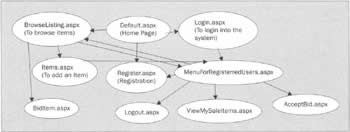Flow of ASP.NET Pages
|
So: we now have the database and our components ready. What we need next is a way to communicate with the components and the users. In this section, we'll look at the flow of the ASP.NET pages used in our application. Once we've got that sorted out, we'll see how these pages can be created in Visual Studio .NET. The above diagram shows how the flow of control passes between the ASPX pages. For example, after users get into the home page, they can go to the login page or the registration page, or they can browse the listings. The direction of the arrow indicates the movement from page to page. Now we can really see the purpose of each page. Default.aspx is the home page where every user first comes in. There are no database calls here; its' just a stopping off point where users can choose where they want to go next. Once the user has logged in, they never return to this page - instead, their home page becomes MenuForRegisteredUsers.aspx, which has different menus. It's from here that users can manage the items they have for sale, accept bids, and so on. One thing to notice is that, as specified earlier, users can browse items for sale whether or not they are logged in. BrowseListings.aspx identifies logged-in users and changes its appearance accordingly, allowing these users to bid on items. Otherwise, just the details of the various items for sale are shown. | ||||||||||||||||||||||||||||||||
EAN: 2147483647
Pages: 263

